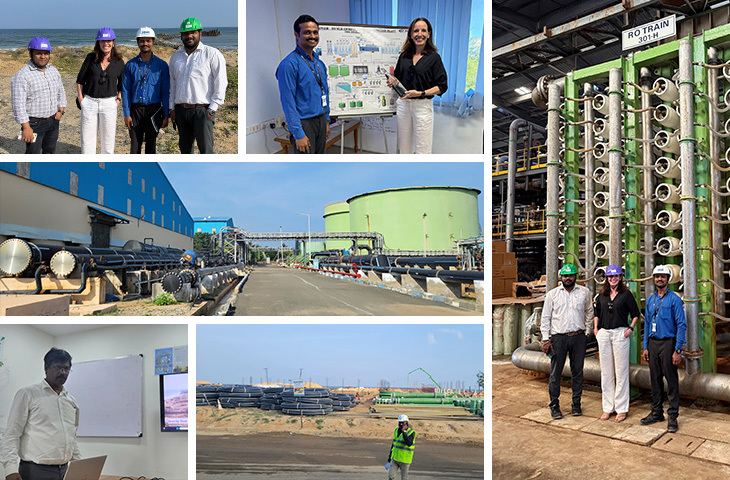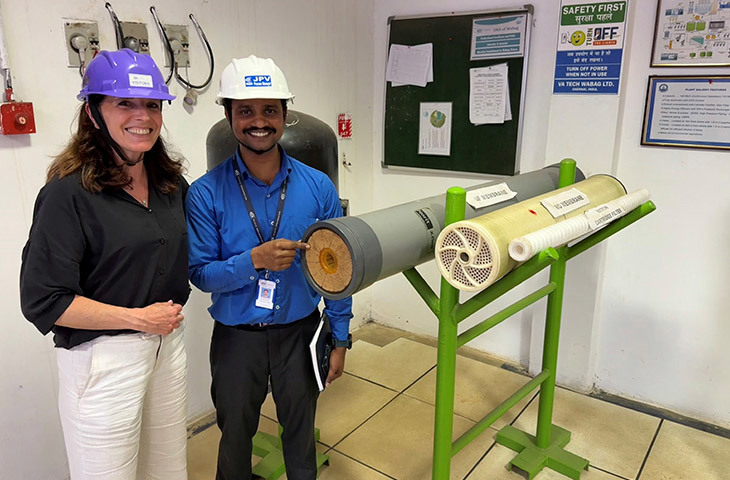The water crisis in India: Challenges and investment opportunities
India faces a severe water crisis, exacerbated by rapid population growth, urbanization, and climate change. With nearly 600 million people experiencing high to extreme water stress, urgent action and enormous investments are needed to address these challenges. During our recent trip to Tamil Nadu, a state in East India and home to 84 million people, we visited the seawater reverse osmosis (SWRO) desalination plant of VA Tech Wabag, India’s largest water technology company, and a holding in our East Capital Global Emerging Markets Sustainable fund.
Water deficit – a critical issue for the world’s most populous nation
According to a World Bank report, India has only 4% of the world’s freshwater resources to meet the needs of 18% of the world’s population. The World Resource Institute cites India as the most water-stressed country in Asia. Water stress, the ratio of water demand to renewable supply, measures the competition over local water resources. A region experiencing “extreme water stress” uses at least 80% of its available supply, while “high water stress” means it withdraws 40% of its supply. Seventeen out of India’s twenty-eight states suffer from “high” or “extremely high” water stress.
Increased water demand is often the result of a growing population and industries such as irrigated agriculture, livestock, energy production and manufacturing. Meanwhile, a lack of investment in water infrastructure, unsustainable water usage policies, or increased climate variability can all affect water availability. (WRI)

Water scarcity in India is driven by a combination of factors, such as the depletion of groundwater (partly due to over-extraction for agriculture and drinking water, leading to alarming declines in groundwater levels), pollution of rivers and lakes from industrial waste and agricultural runoff, which further complicates access to clean water. Climate change exacerbates the issue, with unpredictable monsoon patterns and accelerating glacial melt, directly impacting water resources. Additionally, ill-designed or poorly maintained infrastructure, inadequate water management policies and inefficient pricing contribute to waste and low recycling rates. According to a report by the think tank Centre for Science and Environment, only 28% of urban wastewater is treated in India, while the rest flows untreated back into nature, a reality that is very visible to anyone visiting India.
Government plans
Recognising the significance of water management, the Indian government has launched several initiatives aimed at improving water infrastructure and committed massive funding. The Jal Jeevan Mission, launched in 2019 with a capital outlay of approximately USD 42 billion, aims to provide piped drinking water to every rural household by 2024 (though the initiative is still ongoing). During our meeting with the VA Tech Wabag team, we were told that this laudable initiative demonstrates the Jevons paradox - as increased water availability leads to more water consumption.
Another major plan is the Namami Gange Programme (capital outlay of ~USD 2.6 billion from 2021-2026), which focuses on cleaning the Ganga River and requires huge investments in sewage treatment plants and riverfront development. A third key initiative involves state-level partnerships, where state governments supplement central initiatives with localized investments, enhancing the reach and impact of water projects.
One notable example is VA Tech Wabag’s ongoing construction of a 400 million-litres-per-day (MLD) SWRO plant commissioned by the Chennai municipality. Once completed in December 2026, it will be Southeast Asia’s largest desalination plant in terms of capacity, supplying drinking water to over 2.7 million Chennai residents. The city made headlines in 2019 when officials declared that "Day Zero" - the day when almost no water remained - had been reached, as all four main reservoirs supplying the city had run dry.
On-the-ground: a visit of a reverse osmosis desalination plant
With German origins and a history dating back 100 years, VA Tech Wabag is headquartered in Chennai, the capital of Tamil Nadu in Eastern India and was listed on the Indian stock exchanges - National Stock Exchange (NSE) and Bombay Stock Exchange (BSE) - in 2010. The company specialises in Engineering, procurement, and construction (EPC) contracts and has emerged as a leading pure-play water technology player globally, with a focus on emerging markets. Its operations span the design, supply, installation, construction and operational management of water treatment and desalination plants for municipal and industrial users. While 50% of the company’s revenue comes from overseas, 64% of its order book is domestic.
VA Tech Wabag’s growth drivers come from the manufacturing boom in India – which forces industrial clients to secure water supplies to prevent shutdowns due to shortages, and the urgent need for municipalities to address potable water deficits. Despite its scarcity, water remains underpriced in India – as in many other parts of the world. Located 50 km south of Chennai – though in India, distance is rarely an accurate measure of time (it took us 90 minutes by car)
– the Nemmeli Plant sits along the Coromandel Coast, India's second-largest coastline. Built by VA Tech Wabag between 2010 and 2014, the plant was constructed at a cost of USD 70 million. The company also operates the plant, with its contract period recently extended until 2031. It produces 100 million litres of water per day. I was offered a taste but politely declined, following my gut instinct.

We began our visit with a fascinating run-down of the technical process, given by an enthusiastic Mr J. Parathvairam, the Site Manager. He took us through each step, from the intake of ocean water – one kilometre offshore via 1.6 metre diameter pipes lying on the seabed (divers inspect the inside of the pipes every other month... not a job for the claustrophobic!) – to the actual output of the fresh water, eight hours later. This process includes:
- Pre-treatment – such as screening, coagulation of particles and removal of these solids through filtration
- Reverse osmosis – during which water is forced through semi-permeable membranes before being subject to thermal distillation
- Post-treatment – involving pH adjustment and mineral addition.
While the treatment steps are quite straight-forward, the key process is the reverse osmosis – “the membrane is our hero” the Site Manager said with a big smile – and the hundreds of RO membranes are power-hungry. Energy is 75% of the total cost, a number which explains why desalinated water is nearly 10 times more expensive than treated wastewater.
Armed with this technical knowledge, we set off to tour the plant and inspect the facilities.
A few kilometres away, the construction of the mega 400 MLD Perur Desalination Plant is progressing at a rapid pace, according to the Project Manager, who confidently oversees the massive project. Tamil Nadu Chief Minister M.K. Stalin laid the foundation stone for the plant in August 2023. The Chennai municipality is investing USD 320 million to build what will become Southeast Asia’s largest desalination plant when it becomes operational in 2027.

Conclusion
The water crisis in India is recognised as such by the federal and state governments, which are prioritising water infrastructure. A company like VA Tech Wabag – backed by decades of expertise in large-scale water infrastructure projects, EPC track-record and technical prowess – is very well-positioned to meet the rising demand for fresh water. With its capabilities in both recycled water and desalinated sea-water solution, VA Tech Wabag is poised to play a role in addressing water shortages in its home market and beyond, including the Middle East where the largest SWRO projects are in operation and being built.











